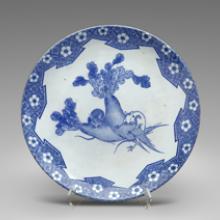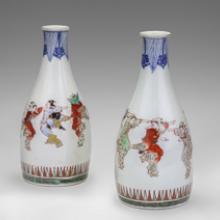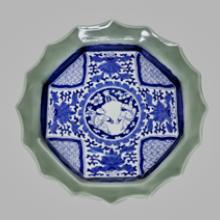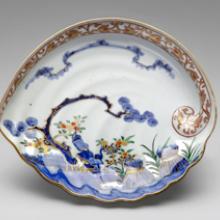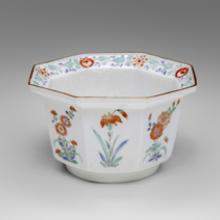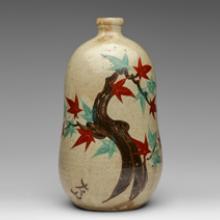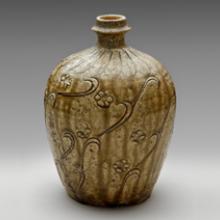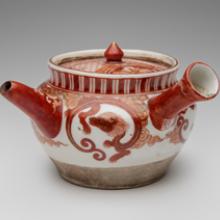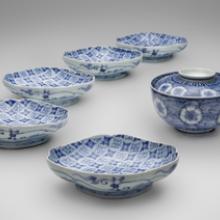International Terminal










Large dish with radish (daikon) and mice 1850–90
Seto kilns, Japan
porcelain with underglaze stencil cobalt decoration
Collection of Richard Mellott
L2010.1401.089
Glazed stonewares were first produced at the Seto kilns during the Kamakura period (1185–1392). The remains of hundreds of old kilns can be found in and around the city of Seto in Aichi Prefecture by the Seto River at the foot of the Hirosaka mountains. Seto potters first achieved production of true porcelain during the opening decades of the 1800s. Seto today remains one of the most noteworthy and celebrated of all the Japanese pottery centers and continues to play a leading role in Japan's ceramic industry. The region became so famous for the production of pottery that the term Setomono (Seto things) has become a general term for Japanese ceramic products, in addition to yakimono (fired things).
Sake containers (tokkuri) early 1900s
Shoza kiln, Kutani, Japan
porcelain with underglaze cobalt and enamel decorations
Collection of Richard Mellott
L2010.1401.014.01-02
Since ancient times, sake or rice wine has played an important role in Japanese culture. Sake is a result of the alcoholic fermentation of a mixture of steamed rice, water, koji (a mold), and yeast. The koji produces an enzyme that converts starch to sugar. It also breaks down proteins as well as other enzymes that are responsible for the aroma and taste of the sake. Quality sake is produced using special sake rice. There are various types, and each one gives the sake its own distinct flavor profile. Sake comes in many varieties, such as filtered or unfiltered, and may be consumed warm or cold.
Large plate with scalloped rim 1800s
Arita kilns, Japan
porcelain with underglaze cobalt and celadon glaze
Collection of Richard Mellott
L2010.1401.020
By the early 1800s, a wave of sudden expansion and development took place in Japan's ceramics industry. Many new kilns were established, with ceramic centers now extending over nearly the entire nation. For the first time, ceramics were used for daily meals by all levels of Japanese society.
Shell-shaped dish 1750-80
Arita, Japan
porcelain with underglaze cobalt and overglaze enamel and gold decoration
Collection of Richard Mellott
L2010.1401.023
The hub of porcelain production from the 1600s to the 1800s was the province of Hizen in Kyushu, the southernmost of Japan's four main islands. The majority of the porcelain-producing kilns in Hizen province (present-day Saga and Nagasaki prefectures) were concentrated in an area known as Arita Sarayama. Arita porcelain workshops centered around a kiln owner (kamamoto or kamanushi) who employed specialist craftsmen to make and decorate pots. The variety of porcelain styles, shapes, and patterns from Arita reflect the differences among the various kilns that produced the wares and the periods from which they date. Porcelain from Arita is often referred to as Imari. This term, however, is really a misnomer, as it simply refers to the name of the nearby port from which these wares were shipped to other parts of Japan and exported to foreign countries.
Teabowl (chawan) 1960s
Gyokuso kilns, Kyoto area, Japan
earthenware with iron glaze
Collection of Richard Mellott
L2010.1401.115
Black-raku (kuro-raku) wares are typically fired in small kilns at relatively high temperatures for earthenwares (usually between 1200–1250 degrees C.). The black, iron-rich glaze matures within only eight to ten minutes, after which the pot is taken out of the kiln and either plunged into cold water or air dried. Since the body has not vitrified after this brief firing period, black-raku can be termed “high-fired earthenware.”
Octagonal bowl c.1690–1700
Kakiemon
Japan
porcelain with underglaze cobalt and overglaze enamel decoration
Collection of Malcolm D. Gutter
L2010.1402.003
The Sakaida Kakiemon family of potters and kiln owners, led by Sakaida Kizaemon (1596–1666), gained prominence for the beauty and quality of its wares in the mid–1600s. The workshops were based in the Nangawara-yama district of Arita Sarayama. In contrast to the ostentatious designs found on overglaze enamel wares, the Kakiemon family developed a distinctive style of painting. The brilliant colors and clear enamel paintings over the glaze display a grace and elegance unlike any other Japanese porcelain. The delicate paintings, rendered by distinguished artisans, display asymmetrical arrangements of flowering trees, birds, animals, and figures. Prominent colors include soft shades of coral red, blue, yellow, and green.
Sake bottle early 1800s
Maruyama kilns, Inuyama, Japan
stoneware, enamel
Collection of Richard Mellott
L2010.1401.010
For centuries, folk pottery was a necessity for many Japanese in provincial towns and cities. Unlike the ceramics made for the aristocracy and the well-to-do merchant classes, folk pottery was intended for daily use, during a time when industrial mass production of porcelain and stoneware did not yet exist. Craftsmen supplying the local demand made some of the folk pottery; others were simply farmers working as part-time potters. Many of these pieces have a simple, organic beauty. Sometimes these coarse kitchenwares were made alongside refined porcelains; other pottery production centers were intended solely as folk kilns.
Bottle 1800s
Seto kilns, Japan
stoneware with glaze and incised, impressed decoration
Collection of Richard Mellott
L2010.1401.015
To all but the ceramic expert, this jar appears to be an exceptional example of a thirteenth-century Seto prunus jar (vase for holding plum blossom branches). The dark, lustrous celadon glaze, the various incised patterns, and the shape, all appear to be correct. However, it is actually a reproduction made during the 1800s.
The glaze on the genuine thirteenth-century pieces is usually lighter in color and applied more thinly and unevenly than the glaze on this piece. The shape of the thirteenth-century body is generally taller and the neck is shorter and wider in diameter. The most obvious error made by the copyist is the use of three different incised patterns on the body. No authentic surviving thirteenth-century pieces have more than two such incised patterns on one piece.
Teapot 1800s
Kutani kilns, Ishikawa Prefecture, Japan
porcelain with enamel and gold decoration
Collection of Richard Mellott
L2010.1401.008a,b
Sencha is both a type of tea and a ritualized ceremony for the preparation of steeped green tea leaves. Teapots, such as this, began to be used during the 1700s in Japanese literati circles in the Sencha Tea Ceremony. For the Japanese, this practice was a means of emulating the refined culture of China, especially that of the Ming dynasty (1368–1644).
Diamond-shaped dishes 1690–1730
Arita kilns, Japan
porcelain with underglaze cobalt
Collection of Richard Mellott
L2010.1401.042.01-.05
Covered bowl 1750–70
Arita kilns, Japan
porcelain with underglaze cobalt decoration
Collection of Richard Mellott
L2010.1401.084
Unlike Europe or China, where diners sit in chairs around a common dining table, the Japanese traditionally ate their meals while seated on tatami floor matting, with a small tray-table for each person. Rather than serving oneself from a large dish that is passed around the table, in Japan, individual servings are laid out before the diner.
Japanese food presentation makes use of numerous small and medium-sized vessels rather than a few large ones. A typical Japanese meal features many different kinds of food served in small quantities. Covered bowls hold soup and rice, shallow receptacles contain fish, and oblong dishes elegantly showcase sushi. Tiny dishes display pickles, relishes, and other small side dishes.
